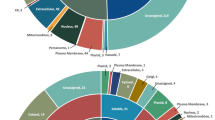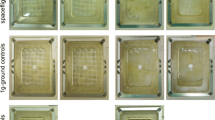Abstract
The transcriptome of seedlings was analyzed from experiments performed on the International Space Station to study the interacting effects of light and gravity on plant tropisms (project named TROPI-2; Kiss et al. 2012). Seeds of Arabidopsis were germinated in space, and seedlings were then grown in the European Modular Cultivation System for 4 days at ~1g followed by exposure to a range of gravitational accelerations (from microgravity to 1g) and two light treatments (blue light with or without a 1 h pretreatment with red). At the end of the experiments, the cassettes containing the seedlings were frozen in the minus eighty laboratory freezer and returned to Earth on space shuttle mission STS-131. The RNA was extracted from whole seedlings and used for the transcriptome analyses. A comparison of 1g spaceflight samples with 1g ground controls identified 230 genes that were differentially regulated at least twofold, emphasizing the need for “in situ” tissue fixation on a 1g centrifuge as an important control for spaceflight experiments. A further comparison of all spaceflight samples with ground controls identified approximately 280 genes that were differentially regulated at least twofold. Of these genes, several were involved in regulating cell polarity (i.e., auxin, calcium, lipid metabolism), cell-wall development, oxygen status, and cell defense or stress. However, when the transcriptome of the all g-treated spaceflight samples was compared with microgravity samples, only ~130 genes were identified as being differently regulated (P ≤ 0.01). Of this subset, only 27 genes were at least twofold differently regulated between microgravity and 1g space samples and included putative/pseudo/undefined genes (14), transposable elements (5), an expansin (ATEXP24; At1g21240), a cell-wall kinase (WAK3; At1g21240), a laccase-like flavonoid oxidase (TT10; At5g48100), among others.


Similar content being viewed by others
Abbreviations
- 1g :
-
1× gravity Earth’s gravitational force
- EMCS:
-
European Modular Cultivation System
- GLACIER:
-
General laboratory active cryogenic ISS experiment refrigerator
- ISS:
-
International Space Station
- MELFI:
-
Minus eighty laboratory freezer
- RT-qPCR:
-
Quantitative real time polymerase chain reaction
- μg :
-
Microgravity
References
Benjamins R, Ampudia CSG, Hooykaas PJJ, Offringa R (2003) PINOID-mediated signaling involves calcium-binding proteins. Plant Physiol 132:1623–1630
Briarty LG, Maher EP (2004) Reserve utilization in seeds of Arabidopsis thaliana germinating in microgravity. Int J Plant Sci 165:545–551
Bustin SA, Benes V, Garson JA et al (2009) The MIQE guidelines: minimum information for publication of quantitative real-time PCR experiments. Chin Chem 55:611–622
Correll MJ, Kiss JZ (2002) Interactions between gravitropism and phototropism in plants. J Plant Growth Regul 21:89–101
Correll MJ, Edelmann RE, Hangarter RP, Mullen JL, Kiss JZ (2005) Ground-based studies of tropisms in hardware developed for the European Modular Cultivation System (EMCS). Adv Space Res 36:1203–1210
Czechowski T, Stitt M, Altmann T, Udvardi MK, Scheible WR (2005) Genome-wide identification and testing of superior reference genes for transcript normalization in Arabidopsis. Plant Physiol 139:5–17
Davin LB, Jourdes M, Patten AM, Kim KW, Vassão DG, Lewis NG (2008) Dissection of lignin macromolecular configuration and assembly: comparison to related biochemical processes in allyl/propenyl phenol and lignin biosynthesis. Nat Prod Rep 25:1015–1090
Guillermo R, Alfonso J, Blazquez MA (2011) Integral control of plant gravitropism through the interplay of hormone signaling and gene regulation. Biophys J 102:2412–2412
Kimbrough JM, Salinas-Mondragon R, Boss WF, Brown CS, Sederoff HW (2004) The fast and transient transcriptional network of gravity and mechanical stimulation in the Arabidopsis root apex. Plant Physiol 136:2790–2805
Kiss JZ, Edelmann RE, Wood PC (1999) Gravitropism of hypocotyls of wild-type and starch-deficient Arabidopsis seedlings in spaceflight studies. Planta 209:96–103
Kiss JZ, Mullen JL, Correll MJ, Hangarter RP (2003) Phytochromes A and B mediate red-light-induced positive phototropism in roots. Plant Physiol 131:1411–1417
Kiss JZ, Kumar P, Millar KDL, Edelmann RE, Correll MJ (2009) Operations of a spaceflight experiment to investigate plant tropisms. Adv Space Res 44:879–886
Kiss JZ, Millar KDL, Kumar P, Edelmann RE, Correll MJ (2011) Improvements in the re-flight of spaceflight experiments on plant tropisms. Adv Space Res 47:545–552
Kiss JZ, Millar KDL, Edelmann RE (2012) Phototropism of Arabidopsis thaliana in microgravity and fractional gravity on the International Space Station. Planta 236:635–645
Livak KJ, Schmittgen TD (2001) Analysis of relative gene expression data using real-time quantitative PCR and the 2−ΔΔCT method. Methods 25:402–408
Masson PH, Stanga J, Neal C et al (2009) Signaling in plant gravitropism. In: Baluska F, Mancuso S (eds) Signaling in plants. Springer, Berlin, pp 209–237
Molas ML, Kiss JZ (2009) Phototropism and gravitropism in plants. Adv Bot Res 49:1–34
Mravec J, Skůpa P, Bailly A et al (2009) Subcellular homeostasis of phytohormone auxin is mediated by the ER-localized PIN5 transporter. Nature 459:1136–1140
Olszak B, Malinovsky FG, Brodersen P, Grell M, Giese H, Petersen M, Mundy J (2006) A putative flavin-containing mono-oxygenase as a marker for certain defense and cell death pathways. Plant Sci 170:614–623
Paul AL, Popp MP, Gurley WB, Guy C, Norwood KL, Ferl RJ (2005) Arabidopsis gene expression patterns are altered during spaceflight. Adv Space Res 36:1175–1181
Paul AL, Zupanska AK, Ostrow DT, Yanping Z, Sun Y, Li JL, Shanker S, Farmerie WG, Amalfitano CE, Ferl RJ (2012) Spaceflight transcriptomes: unique responses to a novel environment. Astrobiol 12:40–56
Porterfield DM, Matthews SW, Daugherty CJ, Musgrave ME (1997) Spaceflight exposure effects on transcription, activity and localization of alcohol dehydrogenase in the roots of Arabidopsis thaliana. Plant Physiol 113:685–693
Ruepp A, Zollner A, Maier D, Albermann K, Hani J, Mokrejs M, Tetko I, Güldener U, Mannhaupt G, Münsterkötter M, Mewes HW (2004) The FunCat, a functional annotation scheme for systematic classification of proteins from whole genomes. Nucleic Acids Res 32:5539–5545
Salmi M, Roux SJ (2008) Gene expression changes induced by space flight in single-cells of the fern Ceratopteris richardii. Planta 229:151–159
Stimpson AJ, Pereira RS, Kiss JZ, Correll MJ (2009) Extraction and labeling methods for microarray using small amounts of plant tissue. Physiol Plant 135:229–236
Stutte G, Monje O, Hatfield R, Paul AL, Ferl RJ, Simone C (2006) Microgravity effects on leaf morphology, cell structure, carbon metabolism and mRNA expression of dwarf wheat. Planta 224:1038–1049
Swarbreck D, Wilks C, Lamesch P et al (2008) The Arabidopsis Information Resource (TAIR): gene structure and function annotation. Nucleic Acids Res 36:D1009–D1014
TAIR: The Arabidopsis Information Resource. http://www.arabidopsis.org/index.jsp. Accessed 2 Aug 2012
Takase T, Nakazawa M, Ishikawa A et al (2004) ydk1-D, an auxin-responsive GH3 mutant that is involved in hypocotyl and root elongation. Plant J 37:471–483
Wolverton SC, Kiss JZ (2009) An update on plant space biology. Grav Space Biol Bull 22:13–20
Xie Q, Guo HS, Dallman G, Fang S et al (2002) SINAT5 promotes ubiquitin-related degradation of NAC1 to attenuate auxin signals. Nature 419:167–170
Zhao C, Craig JC, Petzold HE, Dickerman AW, Beers EP (2005) The xylem and phloem transcriptomes from secondary tissues of the Arabidopsis root-hypocotyl. Plant Physiol 138:803–818
Zhao C, Avci U, Grant EH, Haigler CH, Beers EP (2008) XND1, a member of the NAC domain family in Arabidopsis thaliana, negatively regulates lignocellulose synthesis and programmed cell death in xylem. Plant J 53:425–436
Zhong R, Ye ZH (2003) The SAC domain-dontaining protein gene family in Arabidopsis. Plant Physiol 132:544–555
Zhong R, Burk DH, Naim CJ, Wood-Jones A, Morrison WH, Ye ZH (2005) Mutation of SAC1, an Arabidopsis SAC domain phosphoinositide phosphatase, causes alterations in cell morphogenesis, cell wall synthesis, and actin organization. Plant Cell 17:1449–1466
Acknowledgments
This work was supported by the National Aeronautics and Space Administration (NNX10AF44G to J.Z.K). The authors gratefully acknowledge the support of NASA’s Ames Research Center (Mountain View, CA, USA), especially Marianne Steele, Kenny Vassigh, Ken Souza, Sid Sun, Bob Bowman, Kris Vogelsong, and Dave Heathcote. They also thank the Norwegian User Support and Operations Center (especially Carina Helle Berg, Gjert Aanes, and Knut Olav Helleseng), the European Space Agency, and the EADS team (especially Thomas Niedermaier, Anna Grinberg, and Reinhard Born) for their excellent technical support during spaceflight operations. In addition, Caitlin Bregitzer, Maggie Brown, Jessie Hall, and Katie Huntoon aided in the data collection at Miami University. Special thanks to Astronauts Williams and Creamer as well as other crew members for performing their experiments on board the ISS. The authors also thank Sharon Norton, Dejerianne T. Ostrow, and Yanping Zhang of the University of Florida ICBR, as well as Frédéric Souret, and Veronica Campbell from University of Florida.
Author information
Authors and Affiliations
Corresponding author
Electronic supplementary material
Below is the link to the electronic supplementary material.
425_2013_1909_MOESM1_ESM.docx
Suppl. Fig. S1 The mean RT-qPCR expression levels of JAZ7, CORI3, and MIPS2 from three spaceflight samples relative to two ground controls. The microarray data expression represent the mean from all spaceflight samples (n=16 arrays) and all ground controls (n=6 arrays). For qPCR, the expression ratio was performed using the \(2^{{ - \Updelta \Updelta C_{\text{T}} }}\) method (Livak Method; Livak and Schmittigen 2001) using UBC10 as the reference and ground controls as the calibrators. For arrays, the expression levels represent the fold change (log2) of spaceflight to ground controls (DOCX 71 kb)
425_2013_1909_MOESM2_ESM.docx
Suppl. Fig. S2 RT-qPCR (white bars) and microarray expression levels (dark bars) of DIR7 (At3g13650) from microgravity and incremental g-treatments in spaceflight with two samples from each treatment. The expression ratio was performed using the \(2^{{ - \Updelta \Updelta C_{\text{T}} }}\) method (Livak Method; Livak and Schmittigen 2001). The qPCR analysis used UBC10 as the reference and microgravity as the calibrator. For arrays, the expression levels represent log2 value to baseline divided by the relative to expression from microgravity to baseline. The arrows point to corresponding axis label (DOCX 46 kb)
Rights and permissions
About this article
Cite this article
Correll, M.J., Pyle, T.P., Millar, K.D.L. et al. Transcriptome analyses of Arabidopsis thaliana seedlings grown in space: implications for gravity-responsive genes. Planta 238, 519–533 (2013). https://doi.org/10.1007/s00425-013-1909-x
Received:
Accepted:
Published:
Issue Date:
DOI: https://doi.org/10.1007/s00425-013-1909-x




